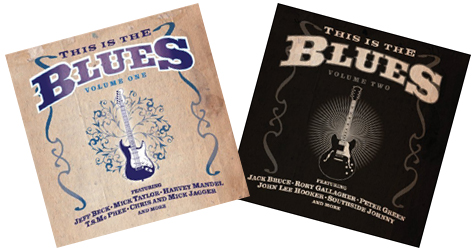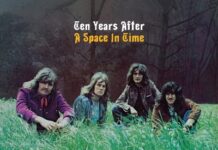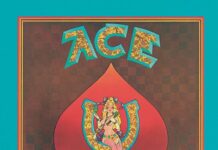This Is The Blues, a new series of CDs from Eagle Rock Entertainment,
has a title that I found slightly misleading. Not that the music can’t be considered
“blues”. It most certainly is that. Down-on-your-luck laments abound.
Guitar strings bend almost to the point of breaking. Sexual metaphors, subtle
and not-so-subtle, are tossed about without a second thought as to whether someone
might find them offensive. That’s definitely the “blues” and describes
the biggest chunk of the first two volumes in what will become a four-volume
set.
For some reason I was expecting a more comprehensive overview of the genre.
Maybe I misunderstood. This Is The Blues would ideally, correct
me if I’m wrong, feature the legends of the genre. Performances by Robert Johnson,
Charley Patton, Bessie Smith, Son House…wouldn’t they be essential to any
comprehensive overview? Not to mention Blind Lemon Jefferson, Blind Blake, Blind
Boy Fuller, Blind Joe Reynolds & Blind Willie Johnson. Now that’s
the “blues” — am I wrong? Songs by Muddy Waters and Leadbelly.
B.B. King with Lucille. Maybe a couple of jaw-dropping performances by Eric
Clapton, Jimi Hendrix and Jimmy Page, who, in their own respective ways, stretched
the whole musical idea of the blues to breaking point. And what collection with
the nerve to call itself This Is The Blues would dare not feature
at least one track by the man who almost single-handedly put straight-up blues
back on the map: the late, great Stevie Ray Vaughn?
No doubt publishing rights are the culprit in why Eagle Rock’s selection doesn’t
meet those admittedly high (impossible?) standards. They probably also have
a lot to do with why Peter Green, troubled co-founder of Fleetwood Mac, has
writing credits for no less than 13 of the thirty songs on these initial volumes.
John Lee Hooker comes in second, with a relatively measly five. I can understand
the difficulty in procuring material, but my mind remains boggled at the relative
overabundance of Green tunes.
And so, without the wherewithal and, I assume, inclination to offer a blues
anthology, the producers of This Is The Blues have chosen to
refer to the series as a “tribute” to the blues. A “musical collective
interpreting some of the greatest blues and blues-rock tunes of all time,”
it says. I can dig that. Even if I don’t recognize a good portion of the collective,
that’s OK. I know a few of ’em, and I’ve heard of a few of ’em, so listening
to these discs should be a good primer for me, right?
The ones I can peg down are heavy hitters, even if only to the long-time classic
rock devotee. I doubt the guy who listens to the local classic rock station
on his way to and from work has ever heard of any of these players. The exception
being a HUGE one, Mick Jagger, who adds a harmonica part to his brother Chris’
contribution, “Racketeer Blues”. A Lonnie Johnson standard, the song
lends itself well to this particular arrangement. Still, there is nothing about
Jagger’s harp blowing that sets it apart from any other moderately talented
harmonica player’s skills. If not for liner notes, it is almost guaranteed that
nobody, even Mick’s biggest fan, is going to know it’s him tooting in the background.
Mick Taylor turns in a tortuously long rendition of Willie Dixon’s “You
Shook Me.” Taylor, who played lead guitar for the Rolling Stones through
the late 60s and early 70s, made his mark with that band but has continued,
in a less public way, to build for himself a reputation as a premiere bluesman.
His work on this tune isn’t bad. Then again, he is a consistent, top-notch guitarist
who has rarely released a substandard recording. But this sucker clocks in at
almost 11 MINUTES! That’s about seven more minutes than this particular version
deserves (maybe eight-and-a-half). It seems to try a few times to pick up some
steam, but never quite builds enough to reward the time invested. Still, to
those of us who know his playing primarily from his stint with the Stones, it
is very interesting to hear him in this element. His vocals have a nice sloppiness
that is in marked contrast to the other version of “You Shook
Me” that everyone knows. Led Zeppelin shot it with sexual energy and Robert
Plant sounded like he was up for some more then and there. Taylor sounds like
the experience wrecked him and it’s gonna be a long recovery.
Another track on the first volume of This Is The Blues that’s
saved by a vocal performance is “I’m In The Mood.” Hanging on to the
microphone, sounding like a rough night spent with Jim B. and Jack D., Jack
Bruce doesn’t so much sing the lyrics as growl them in a lecherous, slightly
creepy manner. He sounds like he’s channeling one of the pioneers of the pre-war
blues era. Of all the songs on this album, “I’m In The Mood” best
captures what I personally think of as the blues. It’s sloppy. It’s dirty. For
this session, Gary Moore, one of the most well-respected blues axe-men currently
on the scene, has been paired with Bruce and drummer Gary Husband to fill out
the trio. He does an admirable job. Neither of them quite have what it takes
to conjure memories of Bruce’s partners in Cream (Eric Clapton and Ginger Baker),
but it is a solid combination nonetheless.
That kid who is still discovering the treasure chest of classic rock has probably
not dug deep enough discover Jeff Beck (or Peter Green-era Fleetwood Mac, for
that matter). But it’s only a matter of time before he will, and when that day
comes, he will rejoice. Old timers, such as myself, have long wondered how Beck
can have released so much quality music and wielded such considerable guitar
skills and yet still be virtually ignored by classic rock radio programmers.
Well, I suppose there is the take on “People Get Ready” he did with
Rod Stewart in the mid-80s, but that one hardly ever sees the light of day.
“Hobo Blues” won’t win him any new fans, but it definitely is worth
hearing, especially if you’ve followed the man’s career over the last 35+ years.
His playing is restrained throughout most of the song, which only makes it more
exciting when he lets loose for a teasing bar or two.
Not quite as well known as Beck, the late Rory Gallagher is in fine form opening
the second volume of This Is The Blues with Peter Green’s “Leaving
Town Blues” (did I mention that there are 13 Peter Green compositions on
this collection? Oh, I did? What the hell is that all about?). The majority
of the songs on the compilation seem like platforms for electric guitar solos,
but Gallagher makes the mandolin the most prominent instrument in this re-working,
and employs a lap steel instead of the Fender Stratocaster that seems to dominate
the rest of the album. It’s a refreshing change and ranks with the Bruce, Moore
and Husband song as one of the best here.
John Lee Hooker is one of only two composers on This Is The Blues
to claim both writing and performing credits. The other is…uh…three guesses?
That’s right — Peter Green, who is given the honor of covering the great
Robert Johnson’s “Traveling Riverside Blues” with Nigel Watson. A
subdued affair that will never be confused with the original, nevertheless it
is one of the album’s more soulful efforts. Hooker’s “Red House” will
certainly never be confused with the original, either. He plays the Hendrix
classic straight and is probably the biggest name in blues working within “the
collective” (okay…maybe Peter Green is just as big, I just don’t know…).
There are a few other recognizable names…and I feel as if I should point
out at this time that when I say “recognizable” I mean it in an entirely
relative way. I won’t pretend that I’ve heard of every one (or even most) of
the names printed in the CD booklets. I’m not a blues enthusiast, as you might
have guessed by my relative unfamiliarity with Peter Green’s influence. I like
it enough, and have played it enough in bar bands over the last few decades,
that I feel qualified in writing about it. I have a good idea of the difference
between the good and the bad, as it pertains to this style of music. But I have
not kept up with it, and as a result I am, in many ways, like that kid driving
to work with the old folks’ music on the radio. Except with me, it’s a blues
station and might as well have been programmed by a close relative of Peter
Green’s.
It’s an interesting mix. Some of the unfamiliar artists make me want to go
deeper into the genre (T.S. McPhee, Larry Mitchell), while others make me want
to change the channel (Zakiya Hooker, Harvey Mandel). But the essence is there,
and I certainly recognize IT. I appreciate the variety offered and the obvious
respect the compilers had for the material (especially Peter Green’s). I look
forward to exploring the catalogs of more than a few players I’ve heard for
the first time on these records, and I think a lot of you will feel the same
way.
Earlier in this review I said this first set of discs in the This Is
The Blues series would make a good primer for me to become familiar
with the newer artists featured here. Having listened to the music several times
since first receiving it, I would have to say that it has been just that. I
think it will work both ways, though. Newcomers to the genre itself will find
copious examples of what makes the blues such a special form of musical expression
(including, but not limited to, the work of Peter Green). Hopefully Volumes
3 and 4 will continue in the same vein, introducing a new generation to the
masters of a timeless tradition. Oh, and at the risk of sounding redundant,
you are gonna LOVE these albums if you’re already a fan of…THE BLUES!!! (Betcha
thought I was gonna say Peter Green, didn’t ya?)




















